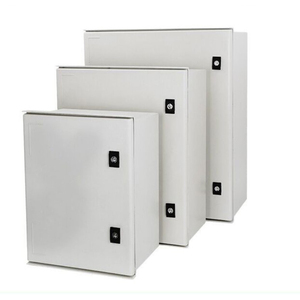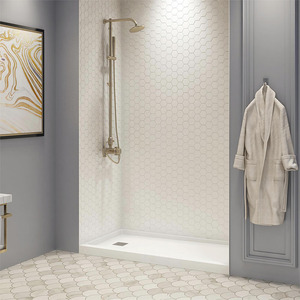(7949 products available)














































































































































































An SMC panel refers to a sheet molded compound that is extensively used in construction. It is a composite material made of glass fibers, resins, and fillers. These components are combined to create strong and durable panels. SMC panels are known for their strength, durability, and lightweight. They are used in various applications, including building walls, roofs, and floors. SMC panels come in different types, including:
The SMC panel has different functions and features. Here are some of them:
High Strength
The primary function of reinforced SMC panels is their strength. Due to their inherent strength, these panels are used in applications where structural integrity is required. For example, these panels are used in constructing containers and equipment casings.
Lightweight
SMC panels are lightweight. Their lightweight nature allows for easier handling and transportation. Additionally, their lightweight nature reduces the overall weight of the final product. For instance, in automotive applications, lightweight materials can improve fuel efficiency and performance.
Corrosion Resistance
SMC panels are designed to be resistant to corrosion. This is a key feature of these panels. Corrosion resistance ensures the durability of SMC panels. For example, SMC panels are used in building electrical enclosures. The electrical enclosures are exposed to moisture and water. Being resistant to corrosion, the panels are able to withstand these harsh environments and be used for a long period of time.
Thermal Insulation
SMC panels have high thermal insulation. For instance, SMC panels are used in constructing cold storage facilities. These panels help maintain low temperatures within the storage areas. This is because their thermal insulation prevents the transfer of heat from outside to inside.
Electrical Insulation
SMC panels possess a non-conductive characteristic. This makes them ideal for use in applications where electrical insulation is required. For example, SMC panels are used in constructing switchgear and electrical cabinets. These panels create safe enclosures for electrical components. Also, they prevent electrical currents from passing through.
Aesthetic Flexibility
SMC panels can be customized to fit different colors and textures. This is a key feature of these panels. For example, SMC panels are used in building exterior facades. These panels can mimic the appearance of traditional building materials such as wood or stone. These panels offer architects and designers flexibility in visual design.
SMC panels are used in different applications and industries. Here are some of their major applications:
Electrical and telecommunications enclosures
SMC panels are used to build electrical and telecommunications enclosures. These enclosures are weather-resistant, stable, and lightweight. Therefore, they protect electrical components and telecommunication devices. SMC panels are molded to create cabinets, junction boxes, and battery boxes.
Transportation and automotive components
SMC panels are used to manufacture automotive and transportation parts. These panels are lightweight and durable, making them suitable for these applications. SMC panels are used to make body panels, hoods, and interior components of vehicles. These panels are also used in the construction of buses, trains, and aircraft components.
Building and construction
SMC panels are used in the construction and building industry. They are used to manufacture building parts because they are resistant to corrosion and weather elements. These panels are lightweight, making them easy to transport and install. SMC panels are used to make façades, roofing, and wall cladding. They are also used to manufacture doors, windows, and electrical conduits in buildings.
Appliances and consumer electronics
SMC panels are used in the interior and exterior parts of consumer electronics and appliances. Their lightweight and insulating properties make them suitable for these applications. SMC panels provide structural support and electrical insulation in consumer electronics. For instance, SMC panels are used in the construction of appliance casings, control panels, and circuit board housings.
Industrial equipment casings
Industrial equipment uses SMC panels to build enclosures and casings. These panels are durable and provide excellent protection against mechanical impact. The enclosures and casings built using SMC panels are stable, impact-resistant, and weather-resistant. As a result, they protect equipment from environmental elements and mechanical impact.
When choosing SMC panels, consider a few factors to ensure the product meets your requirements. Here are some key factors to consider:
Panel application
The first step in choosing a panel is determining its intended application. SMC panels are used in different applications, such as vehicle body construction, electrical equipment housing, and building infrastructure. Each application has different requirements, so it's essential to choose a panel designed for a specific purpose.
Mechanical properties
It's important to consider the mechanical properties of the SMC panels. Assess the impact resistance, tensile strength, and flexural strength. Higher tensile and flexural strength are vital for load-bearing applications, while impact resistance is critical for applications in areas with high impact.
Thermal properties
Consider the thermal conductivity and the heat deflection temperature of the SMC panel. Lower thermal conductivity is critical for insulation applications, while higher heat deflection temperature is essential for applications exposed to high temperatures.
Fire resistance
For certain applications like electrical enclosures or building components, choosing fire-retardant SMC panels is imperative. Look for panels with fire classifications that meet the relevant building regulations and industry standards.
Weight and thickness
The weight and thickness of the SMC panels have a significant impact on their applications. When weight is more important, opt for thinner and lighter panels. On the other hand, thicker panels are suitable for applications that require structural integrity and strength.
Cost
Although it's not advisable to prioritize cost above all else when choosing SMC panels, it's still an essential element to consider. Different products come with different prices, and it's vital to find a balance between quality and budget.
Supplier's expertise and support
The expertise of the supplier and their ability to offer technical support are important factors when choosing SMC panels. A qualified supplier should provide the necessary guidance in selecting the right panels and offer solutions to any challenges that arise during the application process.
Q1: What are the disadvantages of SMC?
A1: The main disadvantage of SMC is its sensitivity to UV light. Prolonged exposure to UV light can cause SMC panels to become brittle and discolored over time. This is why SMC panels are usually reinforced with UV stabilizers or additives. The other disadvantage is that SMC panels are difficult to recycle.
Q2: Is SMC fireproof?
A2: Yes, some SMC panels are fireproof. They are manufactured with a high degree of polymerization. This makes them have a high level of fire resistance. SMC panels are classified into different fire resistance ratings.
Q3: What does SMC stand for?
A3: SMC stands for sheet molding compound. It is a composite material used for making smc panels and other products. SMC is made from polymer resins, reinforcing fibers, and additives.
Q4: What are SMC panels used for?
A4: SMC panels are used for different applications. They include: Electrical enclosures. Due to their corrosion resistance properties, SMC panels are used for making cabinets and electrical boxes. They are also used for making bathroom and toilet cubicles, such as public restrooms. SMC panels are durable and waterproof. They are also used for making walk-in cooler and freezer doors. The thermal insulation properties of SMC panels help to prevent heat transfer. SMC panels are used for making modular building components. These include walls, roofs, and floors. This is because of their lightweight and strong characteristics. SMC panels are used for making transportation vehicles such as trailers, trucks, and buses. SMC panels are lightweight and have a high structural integrity.